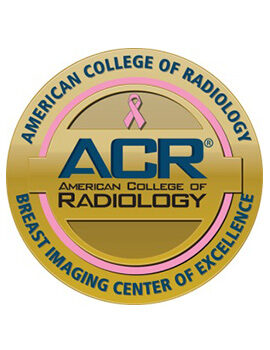The Breast Center at Glens Falls Hospital
The Breast Center at Glens Falls Hospital is an integral part of the C.R. Wood Cancer Center. We offer digital screening technology, such as 3D mammography with 3D guided breast biopsy capabilities, with a team of radiologists and technologists specializing in high quality breast imaging. Specialized breast care nurses in the Breast Center provide clinical care, support, education, and coordination of future breast care needs for all patients.
Breast Imaging Center of Excellence

The Breast Center has been designated a Breast Imaging Center of Excellence by the American College of Radiology. The ACR recognizes breast imaging centers that have earned accreditation in mammography, breast MRI, stereotactic breast biopsy, and breast ultrasound including ultrasound-guided breast biopsy.
A screening mammogram is the best tool available for finding breast cancer early, before symptoms appear. A mammogram is a special kind of X-ray that produces detailed images of the breast that are stored directly in a computer (digital). The Breast Center uses state of the art full-field digital mammography equipment to provide sharper and more detailed images of breast tissue for evaluation.
Mammograms can often detect a breast lump before it can be felt. Also, a mammogram can show small deposits of calcium in the breast. Although most calcium deposits are benign (not cancerous), a cluster of tiny specks of calcium (called micro-calcifications) may be an early sign of cancer.
Who should get a 3D mammogram?
Anyone who needs breast screening should consider 3D mammography. Women with dense breast tissue in particular may benefit because it provides a clearer picture. Using 3D mammography makes it easier for doctors to catch breast cancer early. It also helps us catch more cancers. And it helps us see the cancer size much better than we could on a regular mammogram. It reduces the chances of doctors seeing a false positive. All of our screening mammograms performed at Glens Falls Hospital are performed in 3D.
After having a screening mammogram, approximately one out of 10 women may need a diagnostic mammogram, also called a special view. This is done so that the physician can look closer at a particular area of interest.
If a patient is called back for this type of additional study, she should be prepared to stay a little while longer than for a screening mammogram. This is because the radiologist will review the films immediately in case more images are needed. Often, in addition to these extra mammogram images, an ultrasound is performed to evaluate the area from a different perspective.
Ultrasound is simply another way to look at breast tissue. It uses sound waves to determine relative densities of tissue and helps to clarify whether a particular area of interest is solid or cystic (a fluid-filled pocket). Ultrasound of the breast is performed while the patient is lying down. No compression is needed for this procedure. It is very useful for dense breast tissue.
The purpose of these extra images is to help the radiologist determine if any additional steps need to be taken. Often, it is determined that nothing more needs to be done other than to continue monthly breast self-exams and yearly mammograms with clinical breast exams. Sometimes, a three- or six-month repeat mammogram may be requested. Other times, a biopsy is recommended.
A biopsy is recommended for tissue diagnoses of an area of concern on the imaging studies. There are several ways to perform a biopsy. The nature and location of the lesion may determine the method chosen. Several types of minimally invasive biopsies can be done right in the Breast Center without the need for an open surgical procedure.
Image Guided Breast Biopsy
This procedure can be performed using ultrasound techniques or stereotactic mammography. The stereotactic procedure uses advanced computer imaging technology to map the precise location of the area of interest in the breast in order to obtain a reliable diagnosis with a very small amount of breast tissue. Using a specially designed mammography unit, a series of computerized mammograms are taken which allows the radiologist to identify the abnormality in three dimensions and determine the coordinates of the biopsy.
The skin is cleaned and the area is anesthetized (numbed). A tiny nick is made in the skin where the biopsy device is to be inserted. Small tissue samples are removed from the abnormal area and sent to the pathologist for a diagnosis. The patient visit, including preparation, the biopsy and post-procedure care, takes about an hour.
Ultrasound Guided Core Biopsy
This procedure is used when ultrasound is the best imaging method to guide the radiologist to the area of tissue that needs to be sampled. The skin is cleaned and the area is anesthetized (numbed). The doctor can follow the path of the biopsy device on the video monitor. Tissue samples will be taken and sent for analysis by the pathologist.
Breast (Needle) Localization
When surgery is needed, a breast localization procedure may be appropriate. This is a pre-surgical procedure that uses a fine wire guided by mammography or ultrasound to locate the abnormality for the surgeon. The process begins in the Day Surgery Center, with a trip to the Breast Center before proceeding to the OR suite.
First, a mammogram (or ultrasound) is performed to locate the precise location of the lesion. Then, after the skin has been cleaned and numbed, a needle with a wire is placed into the abnormal area. Once this is done, the location of the needle is verified with additional mammography views or ultrasound. Then, the needle is removed and the wire is left in place in order to guide the surgeon to the abnormality. In the operating room the surgeon will remove the abnormality along the wire, suture the incision and place a dressing over the wound. Once the patient is recovered, she may go home with instructions on how to care for the incision.
Cyst Aspiration
Breast cysts are common and are not cancerous. These fluid-filled pockets may sometimes look like something more concerning and may have to be aspirated (fluid removed) in order to make sure. The physician will place a fine needle into this pocket and remove the fluid. Sometimes, this causes the cyst to disappear completely on subsequent mammograms or ultrasounds.
Galactogram
Also called a ductogram, this diagnostic tool is used to identify a particular duct, a small opening in the nipple, where drainage has been observed. The radiologist will put a tiny catheter into the duct in order to fill it with a radiopaque (shows up on mammographic images) dye. Pictures are taken to show the outline of the duct. There are no special preparations needed prior to this procedure. However, it is important to not express any fluid for several days prior to the exam.
Contact Us
We offer services at three locations. Appointments can be made at any location by calling 518-926-5333.
If you don't have insurance, call the New York State Cancer Services Program at Glens Falls Hospital at 518-926-6570 or 800-882-0121 for information on free mammograms.
Breast Services in the Albany Med Health System
For a complete list of breast services, including locations and providers in the Albany Med Health System, visit our Breast Care pages.
See all Cancer & Tumor Care in the Albany Med Health System.



